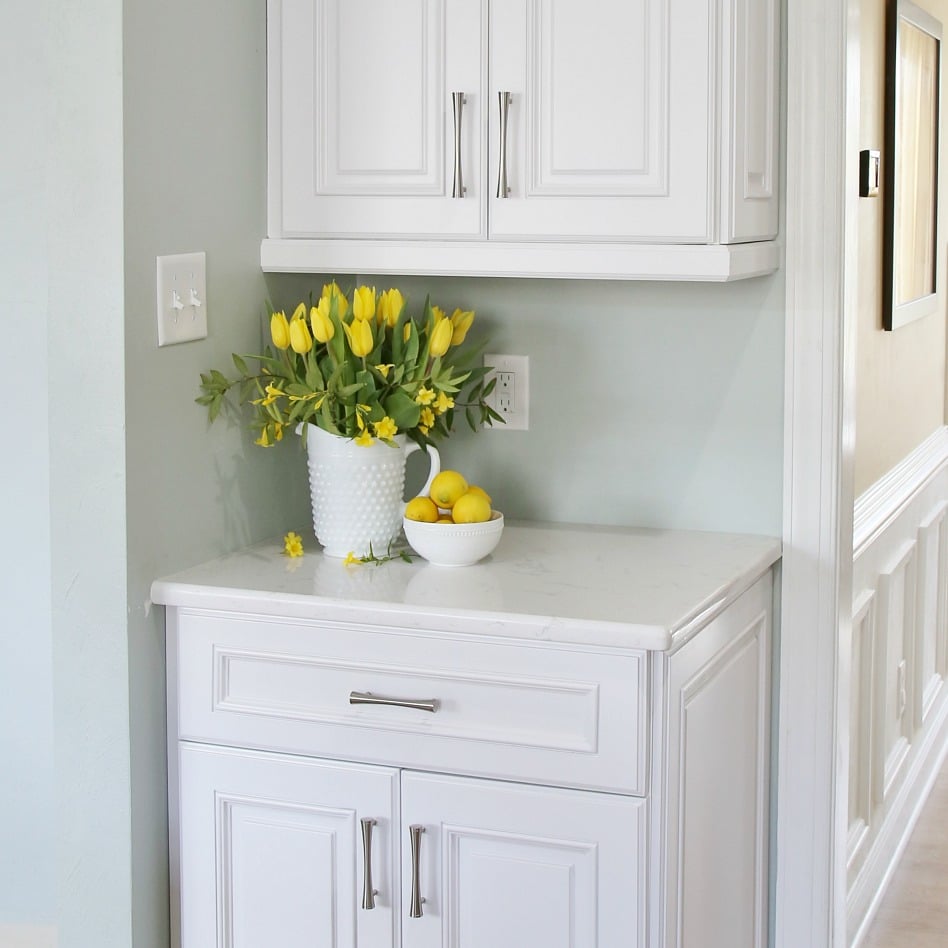The duplex kitchens are looking more and more like real kitchens, and they took a particularly Major leap forward this past weekend after we have All the cupboard hardware installed. But drilling holes into brand new cabinets can be frightening and there is not a whole lot of room for mistakes or do-overs. So unless you’re a fan of buying a whole new door or drawer front, you must get everything based and level on the first try.
Happily, after installing three kitchens-worth of pulls and knobs in the previous year and a half, we’ve perfected our method. So here is how you can keep things right, centered, consistent through the entire kitchen, and bring down the fear-factor when drilling into your new (or freshly refinished/repainted) cabinets. We even included a short video that will take you through each step (and show you a sneak peek at the wood kitchen side of this duplex), so let us get started.
INSTALLING YOUR CABINET PULLS
We left a start-to-finish video while installing one pair of drawers so that you can observe the procedure in real-time. We’ve also shown each step in the photos below if you would prefer to see the measures that way, but the movie will give you a very complete view of what’s involved (and reveal a sneak peek of this timber kitchen side of the duplex).

STEP 1: MARK YOUR HARDWARE TEMPLATES
The hardware templates will be the heroes of the undertaking, so if you are hesitating to invest the $10 on these — THEY ARE COMPLETELY WORTH IT. They’ll save you so much time and anxiety. They have holes for all of the conventional handle spreads (ours were 4″) and plenty of options for just how far down in the cupboard top you might want them placed (we did a two ″ fall ). If you are doing knobs, you will only use the holes down the center at whatever drop you opt for, which is also nice and handy to keep things constant.
Once we have determined which holes will provide us our desired grip placement, we use tape and a pencil to mark them directly on the template using a ring and a huge arrow. There are a whole lot of holes nearby on these templates, and also you don’t want to unintentionally drill through the wrong one at any stage, so whatever you have to do to idiot-proof the procedure would be worth the couple of seconds it requires. This is what ours looks like after we have marked our chosen holes in the right spread (again, your pulls determine that — ours were 4″ pulls) and drop (remember we chose a 2″ fall for all of ours during the kitchen).
STEP 2: TAPE OFF YOUR CABINET FRONTS
Before drilling, put painter’s tape roughly where you are going to hang your own hardware. This not only gives you a surface you’ll be able to mark up without even marking on your own cabinets, but it will also help prevent your cabinet finish from cracking or breaking up as your drill into it. For efficiency, we want to tape off all the drawers in one cabinet at the same time and work our way around the kitchen that way — just taking it one area at a time.
STEP 3: MARK A CENTERLINE ON EACH FRONT
This measure is vital, especially on stacks of drawers like this as you will really notice if one manager is even marginally off-center or not level with the others. So we want to take our time and actually double-check ourselves.
First, measure the entire width of your door. Although ours is a 24″ base cupboard, the drawer fronts themselves are slightly smaller (23 7/8″). Then do whatever math you have to do to figure out half of your drawer front measurement (ours is 11 15/16″ — or just one tiny tick mark within the 12″ lineup ). Once you’re certain of your center measurement, mark it in your blue tape — then double-check yourself by simply measuring again from the opposing side of the drawer to be certain it’s the same on both sides.
I know that last step may seem like overkill, but we captured our own mistakes a few times through this installation (once you are in your 20th drawer, 12 15/16″ begins to look a lot like 11 15/16″). So double-checking in the other side saved us over once from badly placed holes.
As soon as you’ve researched the center on each drawer (you might even wish to do a quick visual verification that they appear to line up with one another) draw your marks somewhat bigger so they will be easier to see in the next measure, and step back to be certain they all look lined up.
More For You:
6 Little Greenhouse Kits You Can Build Yourself
How to Wash Gold and Save from Tarnish Using Simple Pantry Ingredients